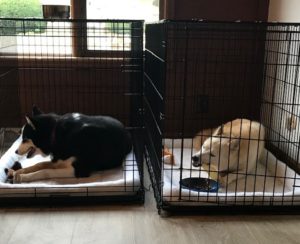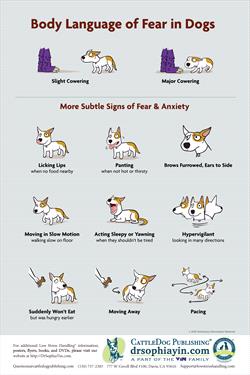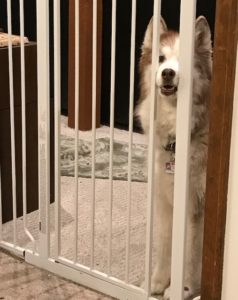Adopting a dog from a shelter or rescue is a very noble thing to do and can mean the difference between life and death for many of these animals. Unfortunately, sometimes people with the best intentions find themselves overwhelmed when they bring their rescue home and are suddenly faced with some unexpected challenges. Educate yourself on best training techniques and learn to recognize brewing fear before you bring Fido home. Utilize your veterinarian and dog trainer as often as you need. Remember, the key to success is being understanding and compassionate during these challenges.
As with most things taught with Low Stress Handling®, preparation is a key element in helping your new dog adjust to its new home. Have you familiarized yourself with the Body Language of Fear in Dogs poster?
This poster should be placed around your home so that every family member can see it and refer to it. Remember that all dogs can bite, and bites happen most often due to fear. It is essential to help your pet settle into his new home as stress free as possible, so being able to recognize his body language will help greatly in achieving this. Another wonderful quick resource for any adopter would be the Learn to Earn Program.
This program is a fun, reward-based program that will help your new family member learn what is expected of him, while teaching him to look to you for guidance, and can help with impulse control. Beginning your training from the moment your dog walks through your front door will not only help establish routine and manners but will build trust and confidence for your dog as well.
In addition to preparing yourself for Fido’s arrival, it is also important to prepare your home. Have you put away that bag of chips sitting on the coffee table? Have you secured the electrical wire for that lamp? Dog-proofing your home is not just for puppies! Never assume that because you may be adopting an adult dog that they will no longer have that urge to chew on that cord, or to check out what yummy stuff they can find lying round the kitchen.
Did you know that some of those fire starters used for home fireplaces are actually quite tasty? Here is a great quick-start guide to dog-proofing your home https://www.rover.com/dog-proofing-your-home/
OK, now that you have read up on dog training, and dog-proofed your home, now what? Well, setting up Fido’s personal little safe space of course! Set up a crate and/or a comfy bed, have a few toys, chews, and other supplies on hand. Basically, have everything you will need for Fido’s arrival ready before he sets one paw in the house. This way, when he comes home for the first time, you can show him his safe place.
I recommend setting this up in an area that is quiet and reinforce this area as the spot he can always go when he is feeling stressed or overwhelmed and just needs a quiet place to relax. Make sure to remind all family members that when Fido is resting in his safe space to leave him be.

Keep in mind that rescue dogs may be anxious and fearful at first, so having this safe place, and allowing them to explore their new home at their own pace is very important.
This home, you, your family, maybe some of your other pets, are all new to Fido. He will need some time to adjust to feel safe and secure. He needs time to get to know you and to learn what is expected of him. Don’t feel frustrated if he has a potty accident in the house. He doesn’t know how to tell you yet that he has to go out to do his business. Maybe he needs some potty-training reminders, and positive reinforcement. Does he get nervous and bark at strangers? That’s OK, he has you to help him overcome his fear of new people and you know how to help him because you were prepared!
Please remember to keep your veterinarian in the loop about any and all behavioral concerns. They are your best resource for support and guidance to help your furry new family member settle happily into his new home.






